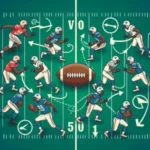American football is a sport defined by its intensity, strategy, and physical prowess, where every inch and ounce can mean the difference between victory and defeat.
As fans cheer from the stands and players clash on the field, one of the most critical yet often overlooked aspects influencing performance lies in the intricate relationship between size, weight, and physics. From the towering linemen who anchor the offensive front to the agile wide receivers darting for the end zone, the physical attributes of each player play a significant role in their ability to execute plays and fulfill their positions. In this blog post, we will delve into the fascinating dynamics of size and weight in American football, exploring how these factors affect speed, agility, and overall performance, while also unpacking the underlying physics that governs the game. Join us as we break down this complex interplay, revealing how understanding these principles can enhance not just player performance but also our appreciation of this beloved sport.
1. Introduction to Physics in American Football
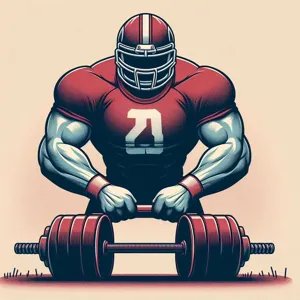
American football is a sport where brute strength meets strategic finesse, and at the heart of this dynamic interplay lies the fundamental principles of physics. Understanding the physics of the game not only enhances our appreciation of the sport but also sheds light on the critical role that size and weight play in shaping performance on the field. From the explosive power of a running back barreling through defenders to the precision of a quarterback’s throw, every movement can be analyzed through the lens of physics.
At its core, American football is a game defined by collisions, acceleration, and momentum. The size of a player can significantly affect their ability to generate force—larger players, often linemen, bring mass that can dominate opponents in scrimmage, while smaller, lighter players may utilize agility and speed to outmaneuver their counterparts. Meanwhile, weight impacts not just physical confrontations but also the gravitational forces that influence a player’s center of gravity and stability on the field.
As we delve deeper into the mechanics of the game, we will explore how these physical characteristics contribute to performance metrics, such as speed, agility, and overall effectiveness in various positions. We will also examine how coaches and trainers leverage this understanding to develop strategies that maximize player performance, optimize training regimens, and ultimately, enhance team success. Join us as we unpack the intricate relationship between size, weight, and performance, illuminating the science that drives one of America’s most beloved sports.
2. The Role of Size and Weight in Player Performance
In the high-octane world of American football, size and weight are more than just numbers on a roster; they play a crucial role in determining a player’s effectiveness on the field. The physical attributes of athletes in this sport can influence everything from speed and agility to strength and endurance. Larger players, often linemen, utilize their size to create formidable barriers against opponents, employing sheer mass to dominate the line of scrimmage. Their weight translates into power, allowing them to push back defensive players and protect the quarterback or create running lanes for ball carriers.
Conversely, skill positions such as wide receivers and defensive backs often benefit from a more streamlined physique. These athletes rely on speed, quickness, and agility, which can be compromised by excessive bulk. The physics of motion suggests that lighter players can accelerate more quickly and change direction with greater ease, allowing them to exploit gaps in the defense or evade tackles more effectively.
However, it’s not merely about being big or small; it’s about how size and weight are optimized for each player’s role. Training regimens and nutrition plans are tailored to enhance specific attributes, ensuring that players can maximize their potential without losing the agility or strength required for their position. even within the same position, variations in body composition can affect performance; a running back may need to balance muscle mass for power with a leaner physique for speed, creating a unique blend of attributes that make them effective on the field.
Ultimately, the interplay of size and weight in American football highlights the sport’s physicality and strategy. Coaches must consider not only the individual capabilities of their players but also how those capabilities align with the overall team dynamics and game plan. By understanding these complexities, teams can maximize performance and gain a competitive edge, proving that in football, every pound and inch truly counts.
3. Understanding Force and Acceleration in Football
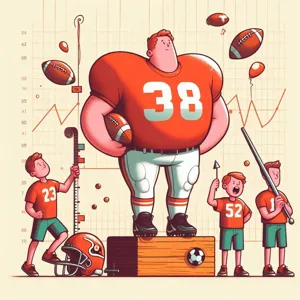
In the high-octane world of American football, the concepts of force and acceleration play pivotal roles in determining a player’s performance on the field. Understanding these fundamental principles can illuminate why certain athletes excel in specific positions, as well as how size and weight influence their effectiveness during gameplay.
At its core, force is defined by Newton’s second law of motion, which states that force equals mass times acceleration (F=ma). This means that a player’s ability to generate force is directly impacted by their mass, or weight, and how quickly they can accelerate. For instance, a linebacker, often one of the heavier players on the field, relies on their mass to deliver powerful tackles. Their ability to accelerate quickly allows them to close the gap between themselves and the ball carrier, increasing the force of their impact.
Conversely, lighter players, such as wide receivers and defensive backs, are typically built for speed rather than sheer power. Their lower mass allows them to accelerate rapidly, making quick cuts and evasive maneuvers that can outpace heavier opponents. In this scenario, the emphasis shifts from raw force to agility and the ability to change direction swiftly, showcasing the intricate balance between size and speed.
Moreover, the physics of football extends beyond individual players; it encompasses team dynamics. When a larger offensive line pushes against a defensive line, the collective mass and force exerted can dictate the outcome of a play. The interaction of forces between players creates a dynamic environment where strategic positioning, timing, and weight all come into play.
Understanding force and acceleration not only informs coaching strategies and player training but also enhances our appreciation of the game itself. Each play becomes a dance of physics, where athletes harness their size, weight, and speed to create moments of brilliance on the gridiron. As fans, recognizing these elements adds depth to our viewing experience, highlighting the remarkable skill and science behind the sport we love.
4. The Physics of Tackling: Mass vs. Momentum
In the high-stakes world of American football, the physics of tackling is a thrilling dance between mass and momentum, each playing a crucial role in determining the outcome of a play. At its core, tackling is not just a test of strength; it’s a complex interaction of forces that can dictate the success or failure of a defensive maneuver.
Mass, often equated with the sheer weight of a player, is a fundamental factor. Heavier players typically possess greater mass, which gives them an advantage in terms of stability and resistance during contact. When a linebacker, for instance, meets a running back head-on, the player with greater mass often has the upper hand, as their body can absorb and dissipate the impact more effectively. This principle is rooted in Newton’s second law of motion, which states that force is the product of mass and acceleration. Therefore, a larger player hitting a smaller one at the same speed can generate a significantly greater impact force.
However, momentum adds another layer to this physical equation. Momentum is the product of mass and velocity, which means a lighter player can achieve considerable momentum by moving at high speeds. Think of a nimble cornerback sprinting to intercept a pass or tackle an opponent. While they may weigh less, their speed can compensate, allowing them to deliver a powerful tackle through sheer kinetic energy. The collision then becomes a fascinating interplay of mass and momentum, where the outcomes can be as unpredictable as the game itself.
To illustrate this further, consider the classic scenario of a fullback barreling down the field versus a safety darting in for a tackle. The fullback’s bulk provides significant mass, making it challenging for the safety to bring them down. However, if the safety times their approach perfectly, exploiting their momentum, they can execute a textbook tackle that turns the tide of the play.
In essence, the physics of tackling in American football is a captivating blend of mass and momentum, where players continuously navigate the intricate balance of force and motion. Understanding these principles not only enhances the strategic approach of players and coaches but also enriches the spectators’ appreciation of the game’s thrilling physicality.
5. Speed vs. Power: Finding the Right Balance
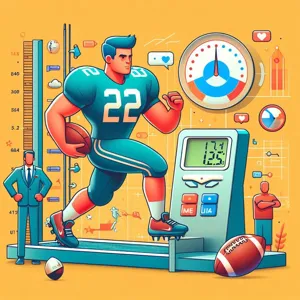
In the exhilarating world of American football, the delicate dance between speed and power can often dictate the outcome of a game. Players come in various shapes and sizes, each bringing unique skills to the field, but the question remains: how do teams find the right balance between these two critical attributes?
Speed, often associated with agility and quickness, allows players—especially wide receivers and defensive backs—to swiftly navigate the field, evade tackles, and execute plays with finesse. A blazing sprint can mean the difference between a touchdown and a turnover. Consider the likes of Tyreek Hill, whose lightning-fast acceleration disrupts defensive strategies and leaves opponents scrambling to keep up. However, pure speed is not enough; it must be complemented by the ability to withstand contact and maintain control.
On the flip side, power is the dominating force that can turn the tide of a game. This is especially true for positions like linemen and linebackers, where strength and mass come into play. A powerful player can bulldoze through defenses, tackle opponents with authority, and create openings for teammates. Think of players like Aaron Donald, whose explosive strength and ability to overpower blockers often lead to game-changing plays. Yet, excessive weight can sometimes hinder mobility, making it crucial for players to condition their bodies to ensure that they can both deliver crushing hits and still keep pace with quicker opponents.
Finding the right balance between speed and power is an intricate process that involves meticulous training and an understanding of individual capabilities. Coaches often emphasize the importance of a tailored approach, where physical conditioning regimens are designed to enhance both attributes without compromising performance. This not only maximizes a player’s effectiveness on the field but also reduces the risk of injury—a vital concern in a sport known for its physicality.
Ultimately, the interplay between speed and power in American football is a captivating study of physics in motion. It’s about harnessing the right combination of force and velocity to outmaneuver, outlast, and outplay the competition. As teams continue to evolve and adapt, this balance remains pivotal—not just for individual players but for the collective success of the entire squad.
6. Position-Specific Performance Metrics
In the world of American football, the size and weight of a player can significantly influence their performance on the field, but it’s the position they play that truly dictates the metrics by which their performance is measured. Each position has its own set of demands, and understanding these unique performance metrics is crucial for both players and coaches aiming to optimize their game strategies.
For offensive linemen, metrics such as bench press strength and agility drills are paramount. These players often tip the scales at over 300 pounds, and their size is a defensive wall against the opposing team’s rushers. Their ability to maintain balance and leverage is measured through drills like the 3-cone drill, which assesses agility and quickness while retaining mass. The correlation between their weight and strength is critical; a heavier lineman who can push back against defenders can create valuable space for running backs.
In contrast, wide receivers and defensive backs are typically lighter and more agile, with performance metrics that focus on speed, route precision, and the ability to leap. Measurements such as the 40-yard dash time and vertical leap are vital for these positions. A lighter, quicker player can maneuver around defenders with finesse, making speed and agility metrics essential for scouting and training.
Running backs represent another fascinating case, where a delicate balance between size and speed is key. While some running backs may weigh in at over 230 pounds, they also need the explosive speed to break through defenses. Their performance is often gauged through a combination of metrics, including yards after contact and agility tests, highlighting their ability to evade tackles while maintaining their weight advantage.
Quarterbacks, the strategic leaders of the team, also have their own set of performance indicators, often combining strength, accuracy, and decision-making speed. While they may not be the heaviest players on the field, their weight plays a role in withstanding the physicality of the game. Metrics like completion percentage and quarterback rating provide insights into their effectiveness, combining physical attributes with mental acuity and tactical execution.
Understanding position-specific performance metrics allows coaches to tailor training regimens that enhance a player’s natural attributes while addressing the physical demands of their role. As the game evolves, so too will the metrics we use to evaluate player performance, but one thing remains clear: size and weight are just part of a complex equation that determines success on the gridiron.
7. The Influence of Size on Injury Risk
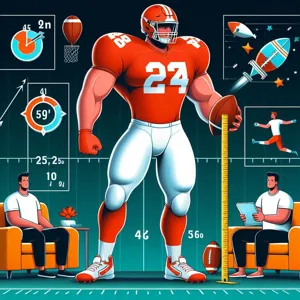
In the high-octane world of American football, size isn’t just a metric of physical presence; it plays a pivotal role in injury risk for players. The intricate dance between weight, height, and body composition can significantly influence how athletes absorb and withstand the brutal impacts characteristic of the game.
Larger players, like linemen, possess mass that can be advantageous for blocking and tackling, yet this same size can make them more susceptible to injuries due to the sheer force they encounter on the field. Studies have shown that heavier players often experience different types of injuries compared to their lighter counterparts. For instance, while a wide receiver may face a higher risk of soft tissue injuries, such as sprains or strains, a defensive tackle might be more prone to joint injuries, given the impact forces they absorb during scrimmages and tackles.
Moreover, the biomechanics of movement also come into play. Heavier players may have different gait mechanics and body mechanics when running or changing direction, which can affect their vulnerability to injury. For example, the increased load on joints like the knees and ankles can lead to overuse injuries or acute trauma during high-impact collisions.
It’s essential for teams to consider these factors when designing training regimens and injury prevention strategies. Customized strength and conditioning programs can help mitigate risks, while proper techniques for tackling and blocking can further protect players from injury. Understanding the influence of size on injury risk not only enhances player safety but also contributes to overall team performance, ensuring that athletes remain on the field where they can make the most impact. As the sport evolves, so too must our approach to player safety, particularly as it relates to the complex interplay between size, weight, and injury risk.
8. Training Regimens: How Size and Weight Affect Conditioning
In the high-octane world of American football, training regimens are meticulously tailored to optimize player performance, and understanding the impact of size and weight is crucial in this equation. The conditioning of athletes is not a one-size-fits-all approach; rather, it must be finely tuned to align with each player’s physical attributes and the specific demands of their position.
Larger players, such as linemen, often focus on building strength and mass to withstand the physicality of their roles. Their training regimens typically incorporate heavy weightlifting, targeting explosive power and core stability. This is complemented by drills that enhance their agility and footwork, ensuring they can maneuver effectively despite their size. Conditioning sessions for these athletes might include sled pushes and resistance training, designed to develop the brute force needed on the line of scrimmage.
On the other hand, skill position players—like wide receivers and defensive backs—tend to prioritize speed, agility, and endurance. Their training regimens are often lighter in weight but higher in repetition, focusing on plyometrics, sprint drills, and agility ladders. These athletes require a finely tuned physique that allows for quick bursts of speed and sharp directional changes. The emphasis here is on achieving a balance between strength and flexibility, enabling them to evade tackles and make swift plays.
Moreover, understanding body composition plays a pivotal role in conditioning. Coaches and trainers often assess players’ weight and body fat percentage to tailor nutrition plans and training schedules that promote optimal performance. For heavyweights, a focus on reducing excess fat while maintaining muscle mass can enhance agility and speed, while lighter players might concentrate on building lean muscle to improve overall strength without sacrificing quickness.
Ultimately, training regimens in football are a delicate dance between size, weight, and performance goals. Tailoring workouts to accommodate the physical demands of each position not only maximizes individual potential but also contributes to the overall success of the team. By recognizing how size and weight influence conditioning, coaches can create customized programs that help athletes thrive on the field, paving the way for a more competitive edge in this dynamic sport.
9. Case Studies: Successful Players of Varying Sizes
When it comes to American football, size and weight often dominate the conversation surrounding a player’s potential and performance. However, history has shown that success can come in all shapes and sizes. To illustrate this point, let’s delve into a few notable case studies of players who have defied conventional expectations and thrived on the field, regardless of their physical stature.
One of the most celebrated examples is the legendary quarterback Drew Brees, who stands at just 6 feet tall and weighs around 209 pounds. Despite being shorter than the typical NFL quarterback, Brees has demonstrated that skill, intelligence, and precision can trump size. His remarkable ability to read defenses, combined with his quick release and accurate passing, led him to become the NFL’s all-time leader in passing yards and touchdowns. Brees’ success highlights that effective play is not merely a matter of physical dominance but also hinges on tactical acumen and mental resilience.
In stark contrast, we have the imposing figure of Aaron Donald, a defensive tackle who measures 6 feet 1 inch and weighs approximately 280 pounds. Donald has consistently proven that his combination of speed, strength, and technique makes him a nightmare for opposing offensive lines. Named NFL Defensive Player of the Year multiple times, his explosive quickness and relentless motor have allowed him to disrupt plays and rack up sacks, demonstrating that a powerful and agile player can redefine the expectations for his position.
Another fascinating case is that of wide receiver Tyreek Hill, whose smaller frame—standing at 5 feet 10 inches and weighing around 185 pounds—has not hindered his ability to make a significant impact on the game. His unparalleled speed and agility allow him to create separation from defenders, leading to numerous explosive plays. Hill’s success underscores the importance of speed and agility over sheer size in the fast-paced environment of the NFL.
These case studies emphasize that while size and weight can play a role in a player’s performance, they are not the sole determinants of success in American football. Instead, attributes such as skill level, game intelligence, work ethic, and adaptability often take precedence. As we unpack the physics of the game, it becomes clear that a diverse array of player physiques can contribute to a team’s success, challenging the notion that there is a one-size-fits-all approach to football greatness.
10. Equipment Design: How Size and Weight Matter
In the high-octane world of American football, the design of equipment plays a pivotal role in both performance and safety, with size and weight being crucial factors that can make or break a player’s effectiveness on the field. From helmets to shoulder pads and cleats, every piece of gear is meticulously engineered to enhance athletic performance while minimizing the risk of injury.
Football helmets, for instance, are designed to be lightweight yet sturdy, utilizing advanced materials like polycarbonate and expanded polystyrene to absorb impact without adding unnecessary bulk. A helmet that is too heavy can impede a player’s agility, making it challenging to execute quick maneuvers, while a poorly fitted helmet may increase the chances of concussions. The balance of size and weight ensures that players can move freely while being adequately protected.
Shoulder pads follow a similar principle. They must provide ample protection without hindering a player’s range of motion. The trend has shifted towards sleeker, more streamlined designs that focus on distributing weight evenly across the shoulders and back. This innovation allows players to maintain their speed and agility, critical attributes in a game where split-second decisions can determine the outcome.
Cleats, too, are a focal point of equipment design, where the size and weight can drastically influence a player’s performance. Lightweight cleats with strategically placed studs enhance traction and speed, enabling players to make sharp cuts and explosive sprints. Conversely, heavier cleats may offer more protection but can slow down a player, making them less effective in fast-paced scenarios.
Ultimately, understanding the physics of size and weight in equipment design is essential for optimizing performance on the gridiron. Coaches and players alike must consider these factors when selecting gear, as the right equipment can lead to improved athletic performance and a reduced risk of injuries, allowing teams to compete at their highest level. As technology continues to evolve, the marriage of science and sport will undoubtedly lead to even more innovations in equipment design, further transforming the landscape of American football.
11. The Evolution of Player Sizes in the NFL
The evolution of player sizes in the NFL is a fascinating journey that mirrors advancements in training, nutrition, and game strategy. In the early days of professional football, players were often larger than life—not just in stature but in their physicality and toughness. The game was dominated by hefty linemen and robust running backs who relied on brute strength and endurance to outmaneuver their opponents. However, as the game has progressed, so too have the dimensions of its athletes.
Today, we see a growing trend towards specialization, with players tailored to fulfill specific roles on the field. The prototypical quarterback has shifted from a bulky, immobile figure to a more agile and athletic version capable of making quick decisions and extending plays with their legs. This shift has led to the emergence of dual-threat quarterbacks, blending the finesse of passing with the explosiveness of running.
Conversely, the demand for speed and agility has led to the rise of lighter, quicker wide receivers and defensive backs. The once conventional size for a receiver—around 6’3″ and 220 pounds—has given way to a new breed of players who are often closer to 6’0″ and 180 pounds, prioritizing quick footwork and sharp route-running over sheer size. This evolution in size and role reflects the NFL’s transition towards a faster-paced game, where skill and speed take precedence over brute force.
Moreover, advancements in sports science and training techniques have allowed players to optimize their bodies for performance, leading to a more nuanced understanding of how weight and size can impact on-field success. Teams now employ nutritionists and strength coaches to help players reach their ideal playing weight, ensuring they maintain the balance between power and agility.
As we look to the future of the NFL, it’s clear that player size will continue to evolve alongside the game itself. With every draft class and each season, we witness the physics of football in action—how the interplay of size, weight, and athleticism shapes the strategies employed by teams and defines the very essence of the sport. This ongoing transformation serves as a testament to the dynamic nature of American football, where adaptation and innovation reign supreme.
12. Strategies for Weight Management and Performance Enhancement
When it comes to American football, weight management is not just a matter of aesthetics; it’s a critical factor that can significantly influence a player’s on-field performance. The physical demands of the game require athletes to strike a delicate balance between size and agility. For players looking to enhance their performance while managing their weight, implementing effective strategies is key.
First and foremost, nutrition plays a vital role. A well-balanced diet, rich in lean proteins, complex carbohydrates, and healthy fats, can help athletes maintain their weight while fueling their bodies for rigorous training and competition. Understanding macronutrient ratios tailored to individual positions can also aid in optimizing performance. For instance, linemen may require a higher caloric intake to support their bulk and strength, while skill position players might focus on lighter, energy-dense foods to enhance speed and agility.
Incorporating a structured training regimen is equally important. Strength and conditioning programs should be designed not only to build muscle mass but also to promote functional movements that enhance agility, speed, and endurance. Plyometric exercises and agility drills can help players maintain explosiveness without adding unnecessary bulk. Additionally, working with a certified trainer can tailor workouts to individual needs, ensuring that players are training effectively for their specific roles on the field.
Moreover, hydration cannot be overlooked. Staying well-hydrated is crucial for overall performance and recovery, especially in a sport that demands high levels of exertion. Maintaining proper hydration levels can improve endurance, reduce fatigue, and aid in injury prevention.
Finally, mental strategies also play a significant role in weight management. Setting realistic goals, monitoring progress, and utilizing support systems—whether through coaching staff, nutritionists, or teammates—can help players stay focused and motivated. Regular check-ins and adjustments to their strategies can ensure they remain on the right path.
In conclusion, by combining sound nutrition, targeted training, proper hydration, and mental resilience, players can effectively manage their weight while enhancing their performance on the football field. Balancing size and agility is not just a physical challenge—it’s a holistic approach that can lead to sustained success in the game.
13. The Role of Nutrition in Optimizing Size and Performance
In the high-octane world of American football, where every ounce can affect a player’s performance on the field, nutrition plays a pivotal role in optimizing both size and functionality. Unlike many sports, football requires a unique balance of strength, speed, agility, and endurance, making the right dietary choices crucial for athletes at all positions.
Players often find themselves in a constant battle between gaining mass to withstand the physicality of the game and maintaining the agility needed to outmaneuver opponents. This delicate balance is achieved through strategic nutrition tailored to individual body types, playing positions, and personal goals. For example, linemen, who rely on sheer size and strength, may consume higher amounts of protein and carbohydrates to support muscle growth and energy levels. Conversely, running backs and wide receivers might focus on lean proteins and complex carbohydrates to enhance speed and agility while avoiding excess weight.
Hydration is another essential component that can significantly impact performance. Dehydration can lead to decreased strength, stamina, and cognitive function, all of which are critical in a fast-paced game where split-second decisions can make the difference between victory and defeat. Many teams invest in nutritional experts who provide tailored meal plans, supplement advice, and hydration strategies to ensure players are in peak condition.
Furthermore, the timing of nutrition is just as important as the content. Pre-game meals, for instance, are meticulously planned to maximize energy stores without causing discomfort on the field. Post-game recovery is equally crucial, with an emphasis on replenishing glycogen stores and repairing muscle tissue through the right combination of nutrients.
In essence, the intersection of size, weight, and performance in American football is not dictated solely by genetics; instead, it’s a complex interplay shaped significantly by nutrition. As players and teams increasingly recognize the importance of food as a performance enhancer, the role of nutrition has cemented itself as a cornerstone in the quest for excellence on the gridiron.
14. Coaching Perspectives on Player Size and Effectiveness
Coaching perspectives on player size and effectiveness in American football can be as varied as the strategies employed on the field. Coaches often have to navigate the delicate balance between physical attributes and skill sets when building their teams. While traditional wisdom might suggest that bigger players have the advantage, many coaches recognize that size alone does not guarantee success.
For instance, a defensive coordinator may prioritize agility and speed over sheer mass when scouting for linebackers. They might argue that a slimmer, faster player can maneuver more effectively around blockers and make tackles in tight spaces, thereby outperforming a bulkier counterpart. Conversely, an offensive lineman’s primary role often demands considerable size and strength to create gaps in defenses and protect the quarterback. However, even in the trenches, coaching philosophies can differ; some coaches advocate for leaner linemen who can utilize quick footwork and technique to outsmart their opponents rather than relying solely on brute force.
Moreover, the evolution of the game has brought an increased emphasis on versatility. Coaches now seek players who can adapt to multiple roles, making size a secondary consideration to skill and intelligence. For example, a running back who possesses both speed and the ability to read defenses can often be more effective than a heavier back who lacks agility. This shift reflects a broader understanding of how the diverse physical attributes of players can complement one another in creating a cohesive and effective unit.
Ultimately, coaching perspectives on player size are continually shaped by the dynamics of the game, player performance, and the ever-changing landscape of athletic training. As teams strive for competitive advantages, the conversation around size and effectiveness remains a critical aspect of strategy, affecting not only player selection but also game play and coaching philosophies at every level of American football.
15. Conclusion: The Future of Player Development in American Football
As we look toward the future of player development in American football, it’s clear that the evolution of training techniques, equipment, and understanding of biomechanics will play a pivotal role in shaping the next generation of athletes. Gone are the days when sheer size and weight were the sole metrics for evaluating a player’s potential. Today, teams are increasingly recognizing the importance of agility, speed, and endurance, alongside traditional metrics. This shift is influencing not only how players are scouted but also how they are trained.
Coaches are beginning to adopt a more holistic approach that includes advanced analytics and sports science, fostering an environment where players can develop their unique attributes while minimizing the risk of injury. With the rise of wearable technology and smart equipment, trainers can now gather real-time data on a player’s performance and body mechanics, allowing for tailored training regimens that optimize strength and conditioning while considering each player’s individual size and weight.
Moreover, the emphasis on nutrition and recovery cannot be overstated. As performance science continues to advance, understanding the nutritional needs specific to each athlete’s body type will become critical in enhancing their overall performance. The future of player development is not just about building bigger athletes but also about creating well-rounded individuals who can adapt to the dynamic nature of the game.
As we move forward, one thing remains certain: the landscape of American football is evolving, and with it, the strategies surrounding player development. By embracing a future that values diversity in body types and skill sets, the sport can not only improve player safety and performance but also enhance the overall quality of the game itself. The next generation of football players may not just be bigger and faster; they may also be more intelligent, adaptable, and versatile, paving the way for a thrilling evolution in the sport that fans and athletes alike can look forward to.
In conclusion, understanding the impact of size and weight on performance in American football is crucial for players, coaches, and fans alike. From the explosive speed of a lightweight wide receiver to the formidable strength of a hefty lineman, each athlete’s physical attributes play a pivotal role in shaping their gameplay and overall strategy. As we unpacked the intricate physics behind these dynamics, it became clear that optimal performance is not just about sheer size or weight but rather the synergy between an athlete’s body composition, skill set, and tactical awareness. As the game continues to evolve, embracing these principles will not only enhance our appreciation of American football but also inspire future generations of players to find the perfect balance between size, strength, and agility on the field. We hope this exploration has enriched your understanding of the game, and we look forward to witnessing how these insights will shape the future of football performance.





